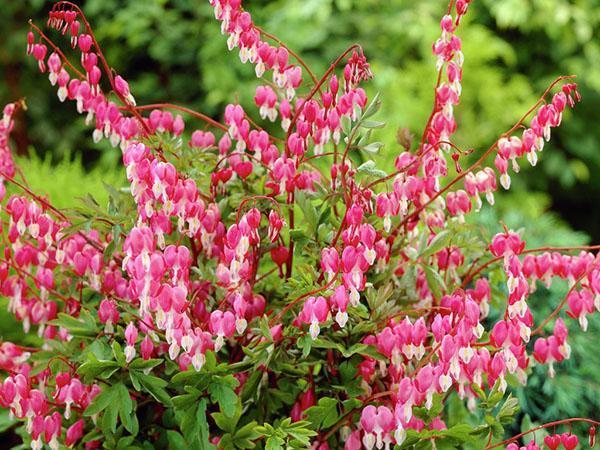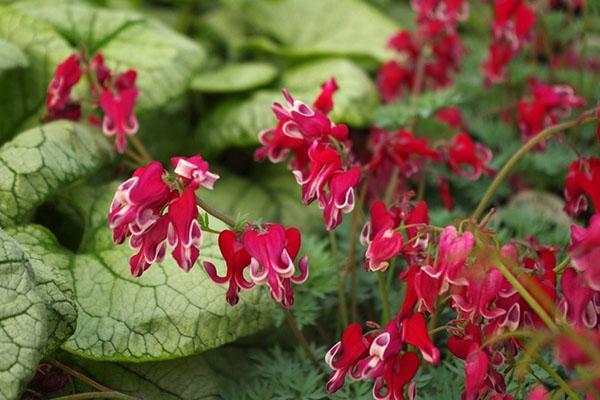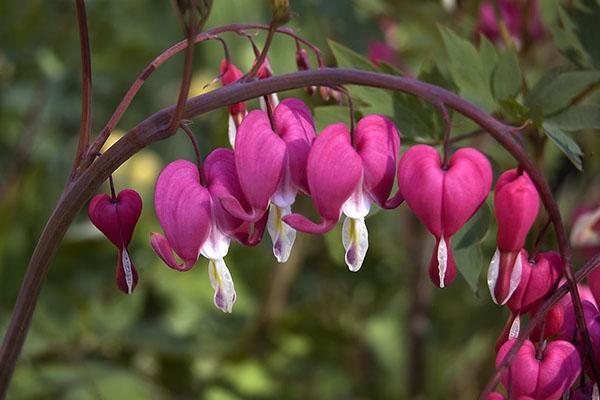Cultivation of dicenter: reproduction and care in the open field
 Growing a dicenter is a simple procedure that even a novice gardener can handle. There was a period when this incredibly beautiful flower, popularly called "broken heart", could be found in every garden, in every city flower bed. Then the dicenter disappeared for a while. This plant is a real find for landscape designers. How to properly plant and care for the dicenter can be seen in the photo below.
Growing a dicenter is a simple procedure that even a novice gardener can handle. There was a period when this incredibly beautiful flower, popularly called "broken heart", could be found in every garden, in every city flower bed. Then the dicenter disappeared for a while. This plant is a real find for landscape designers. How to properly plant and care for the dicenter can be seen in the photo below.
Description of dicenter

In nature, there are about 20 species of this magnificent flower, but there are no more than ten cultivated varieties. There are dwarf specimens, no higher than 15 cm in height, as well as real giants up to a meter or even more in height.
Main varieties:
- Magnificent dicenter. It dissolves its beautiful flowers, collected in racemose inflorescences, in May, but does not please them for long. The plant reaches a meter in height. The top and bottom of the leaf plates have different shades.

- Beautiful dicenter. It does not exceed 0.4 meters. Differs in long flowering: from early summer to autumn.

- Exceptional (excellent) dicenter. The plant looks a bit like a fern because of the gray-blue leaves. Blooms with hearts of white, pink or dark purple color.

- Klobuchkonosaya dicenter. Refers to dwarf species. Its height does not exceed 15 centimeters. The flowers are pink or white. This variety has found its use in pharmaceuticals.

- Climbing dicenter. As the name suggests, this plant is a vine, and an annual one. The specimens reach two meters in height. In addition to light pink flowers, yellow ones are found.

- Burning Hearts or Burning Hearts. This variety is obtained by hybridizing excellent and stray dicentra. The flowers are scarlet. They stand out effectively against the background of silvery foliage.

- Vagrant dicenter. One of the rarest and most ancient varieties. Leaves of an unusual bluish color go well with large white or purple heart-flowers. It is also a dwarf variety that grows up to 15 cm tall.

- Canadian Dicenter. The plant is not large, its height does not exceed 25 cm. The flowers are white, bloom in April.

Site preparation and planting
 In its natural habitat, the dicenter is widespread on the slopes of the Far East, covered with rubble. She does not like an excessively dry climate. On the American continent, varieties that are less demanding on climatic conditions grow.
In its natural habitat, the dicenter is widespread on the slopes of the Far East, covered with rubble. She does not like an excessively dry climate. On the American continent, varieties that are less demanding on climatic conditions grow.
Dicenter, like many garden flowers, is planted before the onset of cold weather and after the snow melts. Before planting a dicenter in spring or autumn, you must first prepare the soil.  For each square meter add 5 kg of humus and dig it up. Soil enrichment is mandatory mineral fertilizersdiluted in water (20 g for every 10 l).
For each square meter add 5 kg of humus and dig it up. Soil enrichment is mandatory mineral fertilizersdiluted in water (20 g for every 10 l).
Heavy soils require lime application.
The size of the fossa depends on the rhizome, usually half a meter. Drainage is necessary to prevent water from collecting near the roots of the "broken heart" and they do not start to rot.  To do this, expanded clay is poured into the recess, ash or sand is mixed into the ground. Since the dicenter forms large bushes, the intervals between specimens should be 0.5 meters.
To do this, expanded clay is poured into the recess, ash or sand is mixed into the ground. Since the dicenter forms large bushes, the intervals between specimens should be 0.5 meters.
Growing dicenter in the open field
 Watering. The roots of the dicentra flower are very sensitive to excess moisture and are easily affected by rot. You cannot transfuse the plant. During dry summers, it is abundantly watered so that the bush does not die.
Watering. The roots of the dicentra flower are very sensitive to excess moisture and are easily affected by rot. You cannot transfuse the plant. During dry summers, it is abundantly watered so that the bush does not die.
 Fertilizer. If the dicenter is not regularly fed, then it will not be possible to achieve lush flowering from it. This plant cannot exist without fertilizers and will degenerate more and more every year. Good results will be provided by spring feeding with humus or superphosphate... During the flowering period, fertilizers from nitrogen compounds are applied under the bush, then the plant will delight longer with branches with "broken hearts". In summer and especially in autumn, humus or manure should be used.
Fertilizer. If the dicenter is not regularly fed, then it will not be possible to achieve lush flowering from it. This plant cannot exist without fertilizers and will degenerate more and more every year. Good results will be provided by spring feeding with humus or superphosphate... During the flowering period, fertilizers from nitrogen compounds are applied under the bush, then the plant will delight longer with branches with "broken hearts". In summer and especially in autumn, humus or manure should be used.
Dicenter can grow in one place for about 5 years. After that, the overgrown roots begin to gradually die off, the plant gives less and less flowers, and then completely stops forming flower stalks.
 Preparing for the winter. Another way to ensure a beautiful bloom of the bicentre is pruning it for the winter. This procedure is carried out after the plant has faded and the foliage turns yellow. All wilted flowers on the plant must be removed. At the end of autumn, the stems are also cut, leaving only 5 cm above the ground. This approach will ensure long life of the plant and good flowering every year. In areas with severe winters, hemp is sprinkled with peat to its full height. You can use spruce branches. If the climate does not differ in extreme frosts, then it is better not to cover the dicenter. She will winter calmly and so. On the contrary, too much insulation of the roots for the winter can lead to the fact that they rot.
Preparing for the winter. Another way to ensure a beautiful bloom of the bicentre is pruning it for the winter. This procedure is carried out after the plant has faded and the foliage turns yellow. All wilted flowers on the plant must be removed. At the end of autumn, the stems are also cut, leaving only 5 cm above the ground. This approach will ensure long life of the plant and good flowering every year. In areas with severe winters, hemp is sprinkled with peat to its full height. You can use spruce branches. If the climate does not differ in extreme frosts, then it is better not to cover the dicenter. She will winter calmly and so. On the contrary, too much insulation of the roots for the winter can lead to the fact that they rot.
Breeding a "broken heart"
Most often, the dicenter is propagated by cuttings or by dividing the bush. The third method, which is rarely used, is with grains.
Seeds
 This is not the most efficient method, so it is best not to use it. If there are no other options, then the seeds of the dicenter are sown in February or March. You can sow in the fall. At an optimum temperature of + 18 ° C, seedlings appear in 3-4 weeks. Young plants dive, cover for the winter with foliage. Dicenter specimens that are grown from seeds begin to bloom in the third year.
This is not the most efficient method, so it is best not to use it. If there are no other options, then the seeds of the dicenter are sown in February or March. You can sow in the fall. At an optimum temperature of + 18 ° C, seedlings appear in 3-4 weeks. Young plants dive, cover for the winter with foliage. Dicenter specimens that are grown from seeds begin to bloom in the third year.
Dividing the bush
 For this, the rhizome of the plant is carefully divided with a knife into several parts so that there are at least three shoots on them. Each segment is planted in a permanent place allocated for it.
For this, the rhizome of the plant is carefully divided with a knife into several parts so that there are at least three shoots on them. Each segment is planted in a permanent place allocated for it.
To make the dicentra bush the most lush, you can plant several of its segments in one hole.
Cuttings
This is one of the most popular breeding methods for the broken heart flower. To do this, choose young shoots, about 12 cm long. They are planted to a depth of 10 cm. It is better to cover the soil with a cuttings with a film or a jar, this will ensure moisture retention.
You can germinate them in a greenhouse, especially if the spring or fall is rather cold. The sprouts appear in about a month, while the roots are also formed. Peat containers are ideal for the rooting of dicentra shoots. Using them, the root system is not injured during transplantation. A year after rooting, the cuttings of the dicentra are planted in open ground.
Dicenter in landscape design
 A beautiful and unpretentious plant is used with pleasure by landscape designers. A lush bush with carved leaves and unique flowers looks amazing both alone and in a group with other crops.
A beautiful and unpretentious plant is used with pleasure by landscape designers. A lush bush with carved leaves and unique flowers looks amazing both alone and in a group with other crops.
Dicenter is combined with coniferous trees. She generally looks great next to tall plants.
If you want to make your flower garden special, then place this touching flower near your house, resembling a broken heart with a tear flowing from it.Photo dicenter in landscape design:





